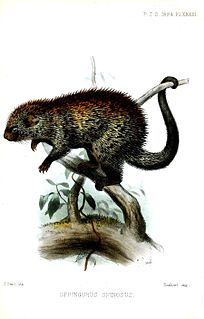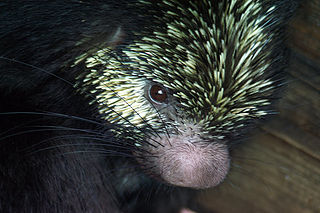
Porcupines are large rodents with coats of sharp spines, or quills, that protect them against predation. The term covers two families of animals: the Old World porcupines of family Hystricidae, and the New World porcupines of family Erethizontidae. Both families belong to the infraorder Hystricognathi within the profoundly diverse order Rodentia and display superficially similar coats of rigid and/or semi-rigid quills which are modified hairs composed of keratin. Despite this, the two groups are distinct from one another and are not closely related to each other within the Hystricognathi. The largest species of porcupine is the third-largest living rodent in the world after the capybara and beaver.

The New World porcupines, family Erethizontidae, are large arboreal rodents, distinguished by their spiny coverings from which they take their name. They inhabit forests and wooded regions across North America, and into northern South America. Although both the New World and Old World porcupine families belong to the Hystricognathi branch of the vast order Rodentia, they are quite different and are not closely related.

The Brazilian porcupine is a porcupine found in Brazil, Argentina, Colombia, Venezuela, Guyana, French Guiana, Peru, Paraguay, Suriname, Bolivia and Trinidad, with a single record from Ecuador. It inhabits tropical forests at elevations up to 1500 m.

The prehensile-tailed porcupines or coendous are found in Central and South America. Two other formerly recognized Neotropical tree porcupine genera, Echinoprocta and Sphiggurus, have been subsumed into Coendou, since Sphiggurus was shown by genetic studies to be polyphyletic, while Echinoprocta nested within Coendou.

The Paraguaian hairy dwarf porcupine, Coendou spinosus, is a South American porcupine species from the family Erethizontidae. It is found in Argentina, Brazil, Paraguay and Uruguay.
The black-tailed hairy dwarf porcupine, Coendou melanurus, is a South American porcupine species from the family Erethizontidae. It is found in Brazil, Colombia, Ecuador, French Guiana, Guyana, Suriname and Venezuela.
The long-tailed birch mouse is a species of jumping mouse found in Northeast Asia. It has been reported from the Ussuri region of Manchuria, Sakhalin Island and Primorsky Krai in Russia, and northern North Korea. It is listed as data deficient by the IUCN.

Tome's spiny rat, also known as Tomes' spiny rat or the Central American spiny rat, is a species of spiny rat distributed from Honduras to Ecuador. The IUCN has assessed its conservation status as being of "least concern".
The spotted bolo mouse or Ecuadorian akodont is a species of rodent in the family Cricetidae. It is known from Ecuador and may also occur in Colombia. Little is known of its status and range.
Scolomys melanops, also known as the short-nosed scolomys, South American spiny mouse, Ecuadorian spiny mouse, or gray spiny mouse, is a species of rodent in the genus Scolomys of family Cricetidae. It is a forest mouse and was thought to be endemic to Ecuador but it is now known to have a wider distribution, being also present in part of Peru.

The white-footed sportive lemur, white-footed weasel lemur, or dry-bush weasel lemur is a species of lemur in the family Lepilemuridae, the sportive lemurs. It is similar in appearance to other lemurs in the family, with a grey back, a pale grey to white ventral side, and a light brown tail. It is a nocturnal animal that moves through the forest using a vertical clinging and leaping technique. It is endemic to Madagascar, inhabiting the southern subtropical or tropical dry shrubland. It is threatened by habitat loss due to agriculture practices and charcoal production.

The bicolored-spined porcupine is a species of nocturnal and arboreal rodent in the family Erethizontidae. It is found in Bolivia, Colombia, Ecuador, and Peru.
The robust tuco-tuco is a species of rodent in the family Ctenomyidae. It is a burrowing rodent and is endemic to the Tucumán Province of Argentina.

The stump-tailed porcupine is a species of rodent in the family Erethizontidae. It is found mainly in Colombia, with a few records from Ecuador.

The Mexican spiny pocket mouse is a species of rodent in the family Heteromyidae. It is native to Mexico and Texas in the United States where it is found in dry, scrubby habitats. The IUCN has assessed it as being of "least concern". It was formerly placed in the genus Liomys, which is now recognized to be paraphyletic and has been subsumed into Heteromys.

The Mexican hairy dwarf porcupine or Mexican tree porcupine is a species of rodent in the family Erethizontidae. It is found in Costa Rica, El Salvador, Guatemala, Honduras, Panama, Mexico, Nicaragua and Belize.
The Andean porcupine is a species of rodent in the family Erethizontidae. It is found in the Andes of northern Ecuador and Colombia as well as in Panama. This porcupine is little known, but is probably arboreal, nocturnal and solitary like its relatives. The species is thought to be uncommon to rare and the population decreasing. It is threatened by deforestation, habitat fragmentation and agriculture.
The lined pocket mouse is a species of rodent in the family Heteromyidae. This pocket mouse is endemic to a small area of central Mexico.












